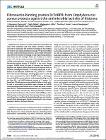| dc.contributor.author | Geoghegan, Joan | |
| dc.contributor.author | Foster, Timothy | |
| dc.date.accessioned | 2019-10-18T11:53:15Z | |
| dc.date.available | 2019-10-18T11:53:15Z | |
| dc.date.issued | 2019 | |
| dc.date.submitted | 2019 | en |
| dc.identifier.citation | Geoghegan, J., Foster, T. Fibronectin-binding protein B (FnBPB) from Staphylococcus aureus protects against the antimicrobial activity of histones., The Journal of biological chemistry, 2019, 294, 3588-3602 | en |
| dc.identifier.issn | 0021-9258 | |
| dc.identifier.other | Y | |
| dc.identifier.uri | http://hdl.handle.net/2262/89844 | |
| dc.description | PUBLISHED | en |
| dc.description.abstract | Staphylococcus aureus is a Gram-positive bacterium that can cause both superficial and deep-seated infections. Histones released by neutrophils kill bacteria by binding to the bacterial cell surface and causing membrane damage. We postulated that cell wall-anchored proteins protect S. aureus from the bactericidal effects of histones by binding to and sequestering histones away from the cell envelope. Here, we focused on S. aureus strain LAC and by using an array of biochemical assays, including surface plasmon resonance and ELISA, discovered that fibronectin-binding protein B (FnBPB) is the main histone receptor. FnBPB bound all types of histones, but histone H3 displayed the highest affinity and bactericidal activity and was therefore investigated further. H3 bound specifically to the A domain of recombinant FnBPB with a KD of 86 nm, ∼20-fold lower than that for fibrinogen. Binding apparently occurred by the same mechanism by which FnBPB binds to fibrinogen, because FnBPB variants defective in fibrinogen binding also did not bind H3. An FnBPB-deletion mutant of S. aureus LAC bound less H3 and was more susceptible to its bactericidal activity and to neutrophil extracellular traps, whereas an FnBPB-overexpressing mutant bound more H3 and was more resistant than the WT. FnBPB bound simultaneously to H3 and plasminogen, which after activation by tissue plasminogen activator cleaved the bound histone. We conclude that FnBPB provides a dual immune-evasion function that captures histones and prevents them from reaching the bacterial membrane and simultaneously binds plasminogen, thereby promoting its conversion to plasmin to destroy the bound histone. | en |
| dc.description.sponsorship | This work was supported by Fondazione CARIPLO Grant Vaccines 2009-3546 (to P. S.) and in part by PRAT-2015 Grant (to V. D. F.). The authors declare that they have no conflicts of interest with the contents of this article. | en |
| dc.format.extent | 3588-3602 | en |
| dc.language.iso | en | en |
| dc.relation.ispartofseries | The Journal of biological chemistry; | |
| dc.rights | Y | en |
| dc.subject | Staphylococcus aureus (S. aureus) | en |
| dc.subject | Adhesin | en |
| dc.subject | Cell surface protein | en |
| dc.subject | Extracellular trap | en |
| dc.subject | Fibronectin-binding protein B | en |
| dc.subject | Histones | en |
| dc.subject | Innate immunity | en |
| dc.subject | Methicillin-resistant Staphylococcus aureus (MRSA) | en |
| dc.subject | Plasminogen | en |
| dc.subject | Virulence factor | en |
| dc.title | Fibronectin-binding protein B (FnBPB) from Staphylococcus aureus protects against the antimicrobial activity of histones | en |
| dc.type | Journal Article | en |
| dc.type.supercollection | scholarly_publications | en |
| dc.type.supercollection | refereed_publications | en |
| dc.identifier.peoplefinderurl | http://people.tcd.ie/tfoster | |
| dc.identifier.peoplefinderurl | http://people.tcd.ie/geoghejo | |
| dc.identifier.rssinternalid | 196586 | |
| dc.identifier.doi | http://dx.doi.org/10.1074/jbc.ra118.005707 | |
| dc.rights.ecaccessrights | openAccess | |




